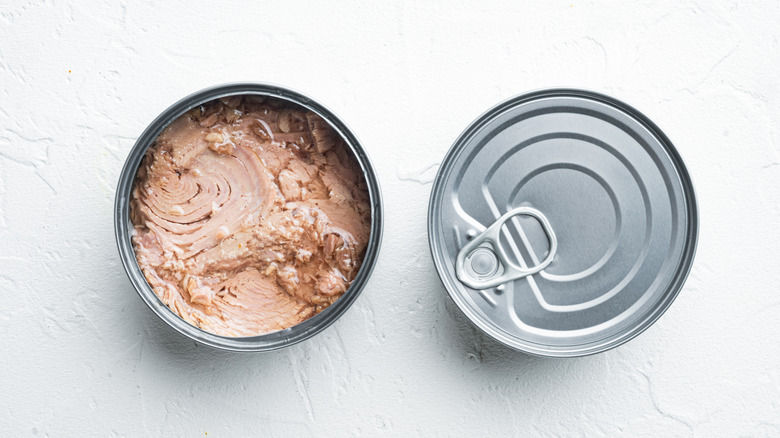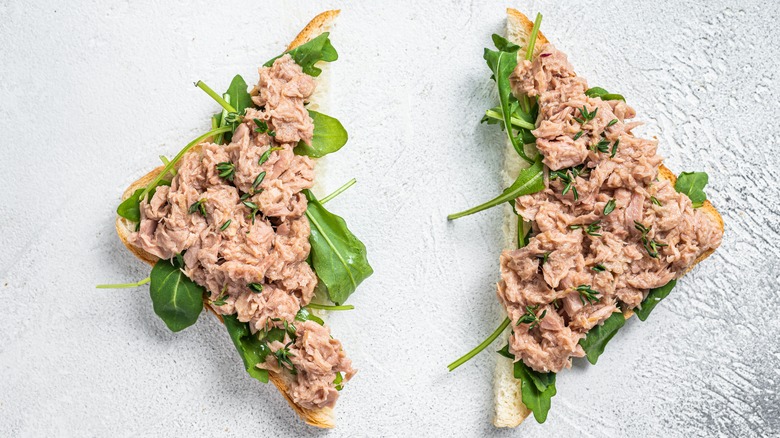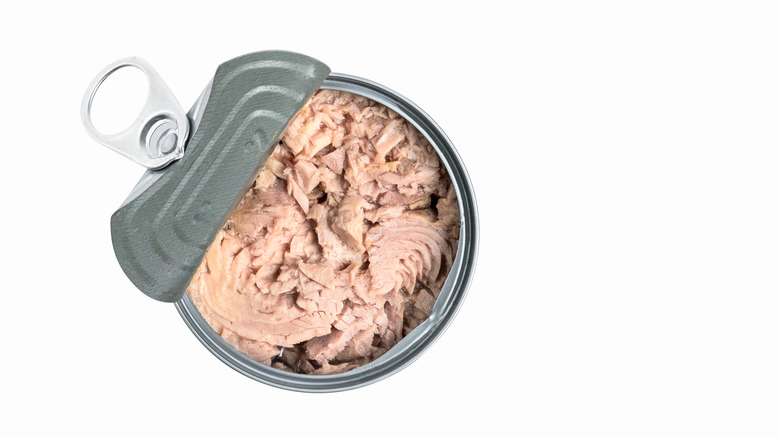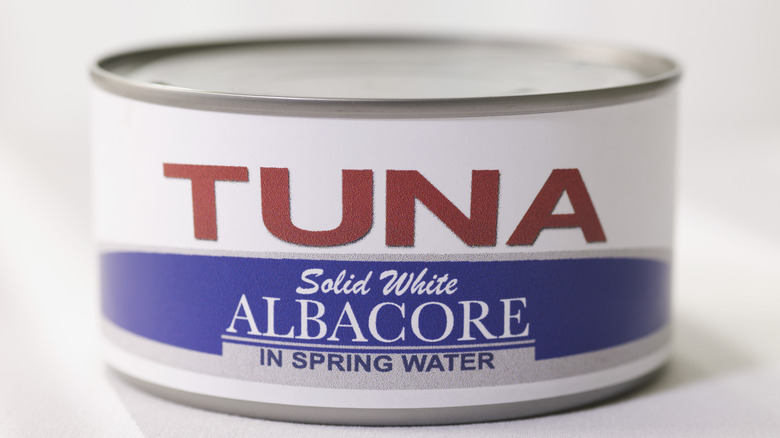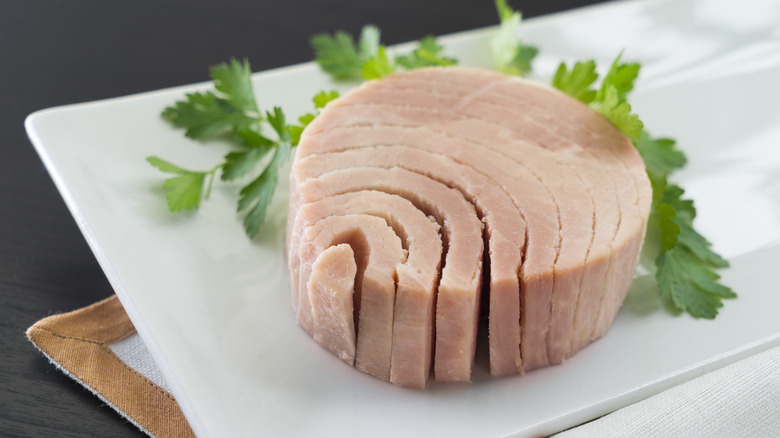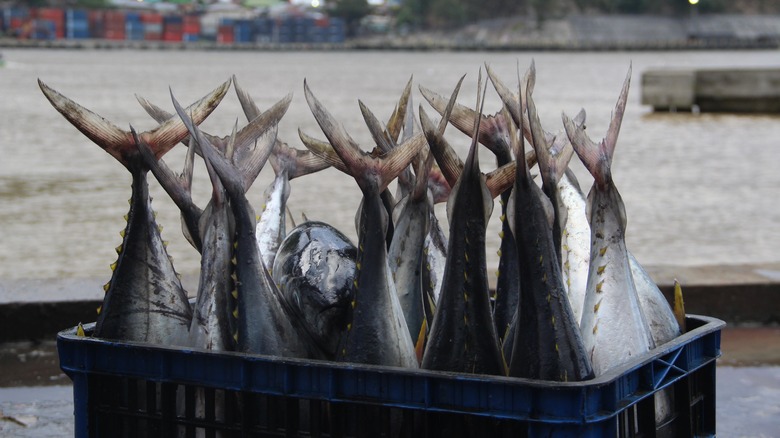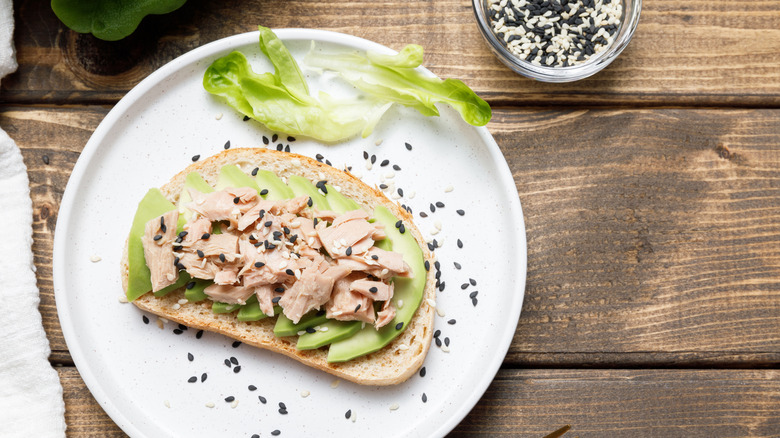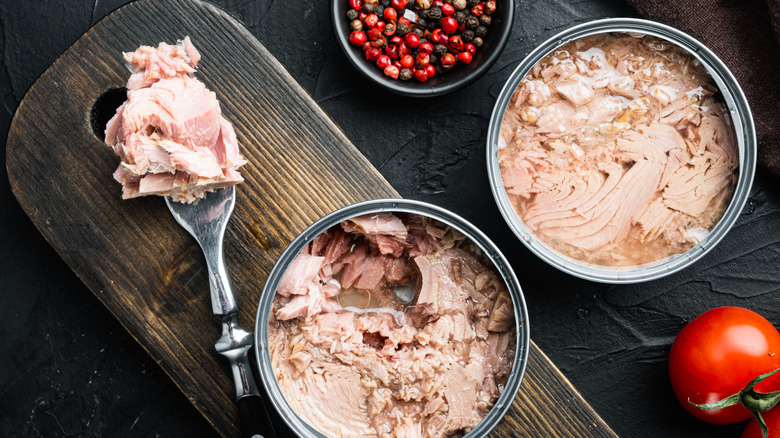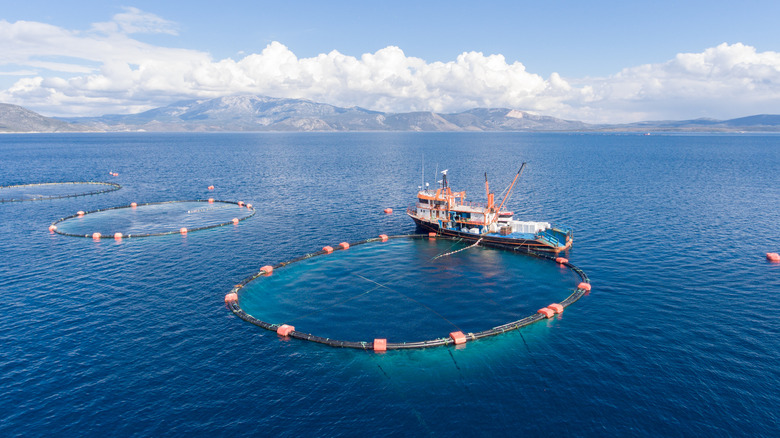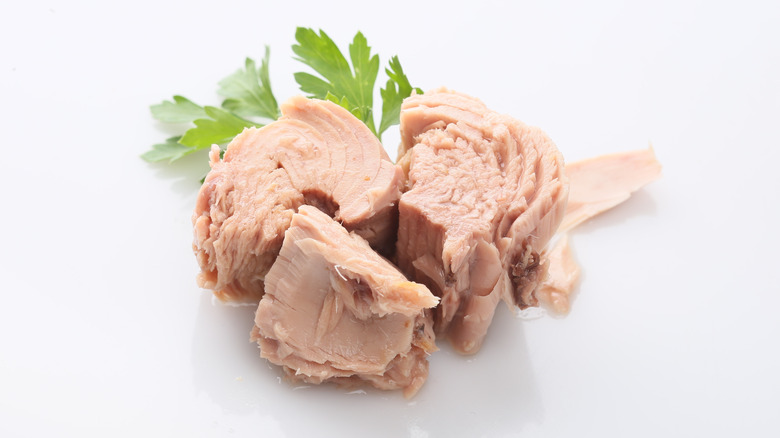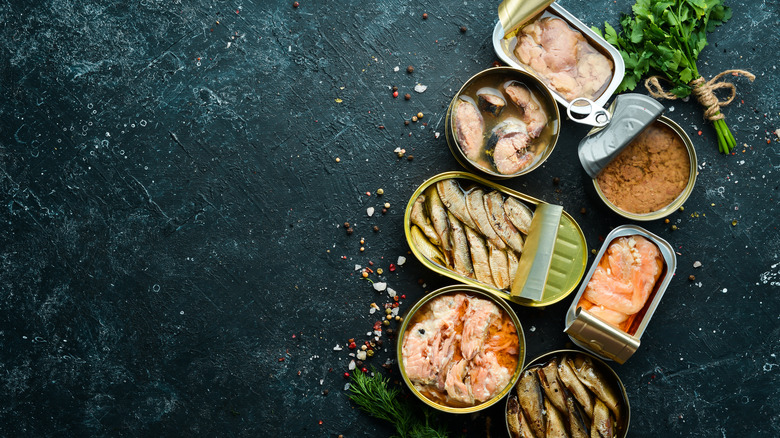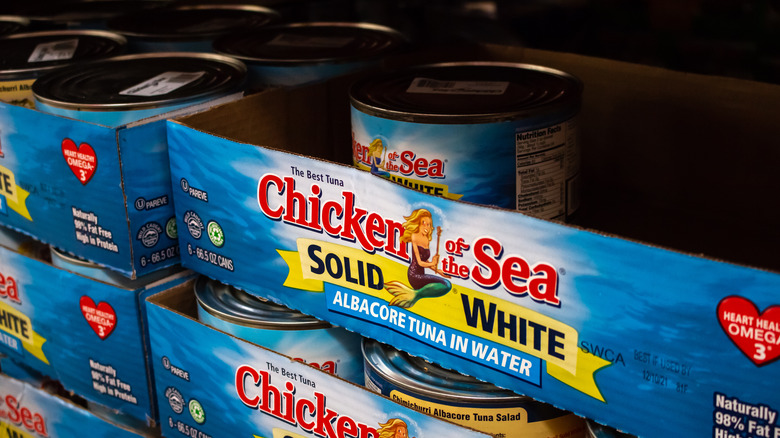13 Myths About Canned Tuna You Need To Stop Believing
Canned tuna is a versatile pantry staple that is unfortunately riddled with misinformation. From concerns about nutrition and sustainability to worries about quality and safety, you've definitely heard one (or several) of these concerning tuna tales before.
Even if you're not on the fence about canned goods, there seems to be no end to the whispers of controversy around tuna, and understandable fears of mercury poisoning, food-borne illnesses, and added toxins and chemicals can make even the bravest chef uneasy.
Rest assured; we can debunk these myths! Canned tuna has come a long way from the key-sealed rectangle cans of the 1930s and brown paper bag sandwiches. Learning why these culinary myths exist can be the key to breaking out of a food rut and help you try something that you originally would have avoided. From the silly to the serious, these myths about canned tuna are ready to be... tackled.
1. Myth: Canned tuna is less nutritious
A common misconception for nearly all canned foods is that canned food, as a premise, is nothing but processed gunk. This leads many shoppers to walk past the canned food aisle and dismiss everything in its vicinity as unhealthy for them. This is commonplace for things like canned soups, canned vegetables, and canned meats like Vienna sausages or spam. Unfortunately, fish receives the same poor reputation as soon as it gets heat-sealed in aluminum.
There are massive nutritional benefits associated with eating fish, and canned tuna is a great way to incorporate it into your diet. Canned tuna packed in water may actually have higher quantities of DHA, an omega-3 fatty acid that is crucial for brain and eye health (via Healthline). The Food Bank of Waterloo Region, a member of Feed Ontario and an affiliate of Food Banks of Canada, states that canned foods are often higher in nutrients because items are at their peak freshness when they are processed. Because of this, canned foods are an accessible way to incorporate healthy choices into your diet without a great deal of expertise and prep.
2. Myth: Canned tuna has added preservatives and chemicals
In a similar vein, a common myth that plagues any prepackaged food claims that they're all filled with chemicals and preservatives that keep canned foods shelf-stable and processed foods fresh. The issue here lies in a misunderstanding of the actual process of food packaging and the additives that are used — especially around how canned tuna is made. When anglers catch tuna for canning, regardless of its species, it is first stored cold until it's time for cooking. The fish is pre-cooked to remove unwanted oils, then the skin and bones are removed from the flesh before canning. Processors pack the tuna into cans or jars with the canning liquid, usually broth, water, or oil, and any seasonings like salt.
The can's lids are vacuum sealed to prevent leakage and then get heated to at least 240 F. This eliminates any disease-causing bacteria, according to Food Source Information. The canning process has been around for centuries, with many home chefs still using a similar method today. If you're still worried about any hidden preservatives in your canned tuna, the Food Packaging Forum has you covered. A 2016 article published by the Danish Consumer Council THINK Chemicals tested 13 cans of tuna and the metal lid of a glass jar of tuna. They found that none of the 13 tested cans or lids contained dangerous quantities of BPA, BFA, or BPS.
3. Myth: Canned tuna is lower quality fish
While this myth could be a stigma that follows cheaply priced items in grocery stores, many consumers still believe canned tuna consists of poor quality fish that isn't good enough to be sold as fresh fillets. Luckily, this myth is relatively easy to bust.
A 2014 Washington Post article describes the downfall of canned tuna's popularity, stating, "In 2012, canned tuna was responsible for just over 16 percent of all U.S. fish and seafood consumption in the country, the lowest reading in nearly 60 years." The author then muses that "canned tuna might become less of a staple — and more of an indulgence."
We can see the truth of this statement in recent years. Canned goods received a makeover to combat falling popularity, and canned tuna has developed a niche market of "luxury." With the rise of tinned fish as a charcuterie staple, grocery store tuna brands from Trader Joe's, Freshé, and Raincoast Trading have created specialty tuna that boast unique flavors, outstanding quality, and a price tag to match. Similarly, the consumer push for environmental practices that consider the environmental impact has likely led to selective sourcing as well.
4. Myth: Canned tuna contains more mercury
Mercury in fish isn't a myth, and it's something to be aware of, but for canned tuna, at least the risk can be mitigated by consumer awareness and some basic tuna know-how. Whether you're purchasing fresh or canned tuna, it's crucial to understand where your fish came from. Keep an eye out for recent reports of pollution in the areas that your preferred tuna brand sources from. In the event of a serious pollutant, the Harvard Medical School says it may be time to switch to a new brand or keep a close eye on FDA reports.
The National Resources Defense Council (NRDC) explains that certain types of tuna, specifically Ahi, bigeye, and albacore, contain the highest levels of mercury. The NRDC clarifies that an adult woman can eat about two 6-ounce cans of tuna and stay below the recommended limits. Beyond the NRDC, many health experts recommend sticking to light or skipjack tuna to be safest (via Time). Canned albacore or white tuna is popular and readily available. However, skipjack or light tuna is often more accessible and boasts a cheaper price tag — especially when compared to its fresh counterpart, Ahi tuna.
5. Myth: Canned tuna is mainly sourced in the US
While tuna is still a staple in the American diet, canned tuna accounts for 60% of all canned seafood consumed in the US, according to Seafood Health Facts. Despite this, the business is distinctly un-American.
Americans consume roughly 1 billion pounds of canned tuna yearly (per the National Fisheries Institute), but most canned tuna is produced in Southeast Asian countries.
From a 2019 article by The ASEAN Post, Thailand ranks as the world's top exporter of canned tuna. The country makes up 29% of all exported tuna, with Indonesia, Vietnam, and the Philippines following behind. That's impressive enough on its own, but with one of Thailand's biggest canned tuna companies — Thai Union Frozen Products, purchasing Chicken of the Sea in 1997 and Bumble Bee in 2014 (per the Washington Post), the biggest names in American grocery stores have little to do with America.
To clarify, none of these brands are bad simply because they sell exported products. The same ASEAN Post article claims that a 2018 Greenpeace study finds that many of these fisheries are working with sustainability efforts and changing their processes to maintain safe labor and environmental standards.
6. Myth: Canned tuna leads to obesity and high cholesterol
Similar to the myth about canned tuna being low quality, the myth that canned tuna leads to obesity and raises cholesterol is a myth that's pervasive in American society. Canned goods get a poor reputation for being overly processed and laden with added ingredients like sugar and excess fat. According to TriHealth, however, canned tuna ranks highly as a food that helps lower cholesterol. Experts state that while fish is an excellent way to lower cholesterol, species like tuna, salmon, sardines, and herring are some of the best. Because they contain such great nutrients and high levels of omega-3 fatty acids, adding more fish to your diet is fantastic — and canned tuna makes adding fish accessible.
Research aggregated by Healthline reiterates this statement explaining that tuna is a high-protein food that helps those attempting weight loss to stay full longer. Tuna packed in water lowers calories and provides essential nutrients that keep you healthy.
7. Myth: Canned tuna is high in sodium
This is one of those myths that's occasionally true. There are absolutely brands of canned tuna with excessive sodium levels, but you shouldn't discount canned tuna because of a few outliers. Fisheries frequently use dissolved salt as a natural preservative and flavor enhancer in processed foods. This is especially common when brine is used in canning or pickling, per a CDC info page on sodium. Americans frequently consume much more than the recommended daily value of sodium, approximately 3,400 milligrams each day.
MedicineNet clarifies that excessive salt can lead to heart problems, including high blood pressure. However, consumers can choose products with low sodium or no sodium options. If you cannot find canned tuna with no or low sodium, LiveStrong recommends you rinse regular tuna packed in water to remove extra salt. This process can reduce salt content by 80% and helps make your canned tuna a worry-free ingredient.
8. Myth: Canned tuna is bad for the environment
Environmental concern has become an important topic in today's world. While it's no myth that fishing can put an incredible strain on the environment, there are ways to minimize the impact your canned tuna has on our oceans. Want to start sustainably eating seafood but find yourself completely lost on where to start? You're not alone, according to NPR. The biggest struggle amongst green-minded seafood enjoyers is the ridiculous amount of conflicting information available, even from the top seafood watch websites.
The Monterey Bay Aquarium Seafood Watch and the Environmental Defense Fund's Seafood Selector both use the same scientific information but label their findings in different ways. Even if you feel you understand the data, it's difficult to trace sourcing information if you're not buying specific brands that advertise their sustainability. Luckily, Seafood Watch has some suggestions for how to identify the canned tuna brands that are taking action toward sea stewardship. When you're inspecting the label on your canned tuna, check for descriptors such as pole-caught, troll-caught, or school-caught. These ways of fishing have very little by-catch — the accidental catch of other marine life, like dolphins, seabirds, and turtles.
If you are completely against the idea of commercial fishing and its environmental impact, farmed fish may be an option for you. While farming fish raises its own green concerns, FoodPrint's 2020 report on farmed seafood offers hopeful suggestions for sustainable aquaculture.
9. Myth: Canned tuna can give you food poisoning
If you've ever eaten a meal and felt unbearably sick afterward, you can empathize with the fear behind this myth. Food poisoning impacts approximately 48 million people annually, according to the CDC, making it one of the most common illnesses in the United States. With canned fish, the two biggest food-borne illnesses are botulism and scombroid. Canned foods that are severely dented, have bulging lids and/or sides, or show signs of rust can show potential spoilage. Thankfully, botulism is rare in commercially canned goods unless the can is damaged. However, the USDA reinforces that keeping oxygen out of sealed cans is the most important thing to prevent the growth of harmful bacteria, which causes poisons and neurotoxins like botulinum to develop.
For scombroid fish poisoning or histamine fish poisoning, even canned or preserved fish can be susceptible (via the National Library of Medicine). When transporters don't properly chill the fish throughout the entire transportation process, bacteria can break down the meat of the fish and cause high levels of histamines.
Luckily, doctors can treat scombroid poisoning with over-the-counter antihistamines, according to the Minnesota Dept. of Health, and purchasing from a reputable supplier or brand inspected by the FDA can nearly eliminate this issue.
10. Myth: Canned tuna is all made of the same type of fish
We can prove this myth false simply by taking a trip down our local grocery store's canned goods aisle. Amongst the towers of vegetables, soups, and canned ravioli are tons of different canned tuna brands with hundreds of labels. The most common labels you'll see, according to the canned seafood magnate Bumble Bee, are "Solid White Albacore Tuna," "Chunk White Albacore Tuna," and "Chunk Light Tuna." There are a few differences between these types. Solid tuna is a whole fillet of fish, but chunk tuna comprises larger pieces of fish. The significant differences, however, come from the labels white and light.
Per Oceana, the descriptor "white" on a canned tuna label means you're getting only albacore tuna, a larger fish with a pale color and a firm texture. "Light" tuna refers to a smaller species called skipjack tuna that is considered healthier for its lower mercury levels. If you come across a label stating "tonno," "gourmet," or "premium," it contains yellowfin tuna; still, they're more uncommon than albacore and skipjack tuna.
11. Myth: Canned tuna shouldn't be cooked
This one may be a lesser-known myth, but some people swear that canned tuna is only good for a simple tuna salad recipe. That's a tragedy, considering canned tuna is a versatile ingredient that lends itself beautifully to a huge variety of dishes across many global cuisines. Perhaps the simplest and most well-known of these options is the classic tuna melt. Toasted bread, perfectly melted cheese, and delectable tuna salad elevate a cold tuna sandwich to new heights and can be the perfect way to ease picky eaters into the world of cooked, canned tuna.
If you're already comfortable with the delicacy that is a tuna melt, try exploring further with this tuna pot pie recipe instead of chicken pot pie. You can create an easy weekday meal with the iconic potluck tuna casserole or even broaden your culinary horizons to the extreme with a crispy, golden tuna croquette.
12. Myth: You should never buy tuna canned in oil
American diet culture has profoundly impacted our society, and the myth that tuna canned in oil is a taboo foodstuff is a sad byproduct of that. It's a mistake about canned tuna that many make. The truth is tuna packed with oil elevates the flavor, can boost nutrition content, and improves the texture of the canned fish. There are differences between tuna in water versus tuna packed in oil, but both options have their uses depending on the recipe you're working with.
If you're using tuna in a recipe that requires you to drain and dry the fish, tuna packed in water may be your best bet. Draining oil-packed tuna can actually remove some of the omega-3s it contains. If you want to keep your oil-soluble nutrition content at its highest, avoid canned tuna in oil unless you intend to use the oil in your recipe. If you're looking to splurge or consider yourself a seafood aficionado, gourmet tinned tuna packed in oil makes for some of the most decadent and flavorful fish on the canned seafood market. Things like a delicious marinade, sustainability, and quality can help to justify the cost of some of these more expensive options. If you love tuna, it's worth trying at least once.
13. Myth: Canned tuna is actually chicken
Granted, this one is ridiculous, but you'd be surprised how many people misunderstand the brand Chicken of the Sea. "Just like chicken" is a common colloquial term to describe any meat with a firm texture and a mild flavor. We usually understand the moniker as a joke, especially when we're talking about fish. According to the Chicken of the Sea brand itself, the name came after the brand was originally founded. Chicken of the Sea tells the story this way: "In the early 1900s, tuna fishermen used to joke that white albacore was "the chicken of the sea" because of its mild flavor and light color. If you've ever wondered where our name comes from, now you know!"
Though tuna differs incredibly from chicken, we can't blame chefs for comparing quality tuna with its firm texture, delicious flavor, and versatility with a staple kitchen ingredient. They both have their place in the kitchen, and with culinary exploration, both can create delicious meals perfect for any palate.
